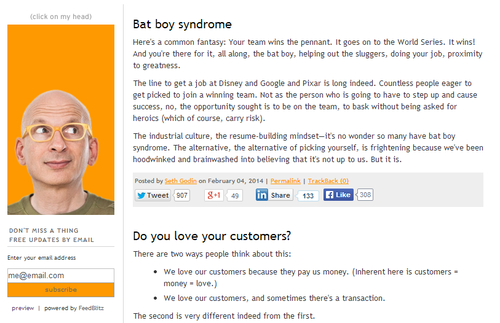
Before you realize, habits form. How much thought do you put into your daily routine, and how much of your routine is formed as a response to outer influence? In other words, do you know why you work the way you do?
Being purposeful with your work philosophy might be the missing key to achieving a healthy rather than hasty, always running-behind pace. Understanding the psychological benefits of controlling the flow of your time and attention reveals the wisdom in taking things slow.
Slowing Down Your Fast Web
Getting swept along the digital flow of constant information is the status quo for many folks whose days revolve around the internet. And that’s where the problem lies. Our days shouldn’t really revolve around the Internet.
The Slow Web movement takes a different approach to the shiny real-time demands of the Fast Web. Rather than advocating a withdrawal from all things digital, Slow Web is about mindful interaction dictated by your schedule rather than someone else’s headlines, upvoting, tweets, emails, and feeds. There’s value in the ability to set notifications to your moods and cycles and to turn off devices to pursue other interests and meet other needs.
The slow web is about you and your awareness. In many ways, this conscious approach fits with how we are wired to work best. Let me explain:
Overtaxed + Overwhelmed = Vulnerable
One of the byproducts of a fast-paced internet lifestyle is the crushing weight of information — and inside this snowball is where the danger lies. You’re more likely to get tricked into believing false information when you’re tired and distracted.
Called Automatic Believing, this theory has a direct application for seedy marketers: Persuade people when they are distracted or overwhelmed.
 For example, it’s no accident that the big sales push at a timeshare meeting comes at the end when the audience is fatigued and stuffed full of information. Features and rates start sounding a lot better when you’d just like to get out of there.
For example, it’s no accident that the big sales push at a timeshare meeting comes at the end when the audience is fatigued and stuffed full of information. Features and rates start sounding a lot better when you’d just like to get out of there.
By default, our brains are conditioned to regard something as true as soon as we consume information. We believe first and ask questions later. This M.O. helps us assimilate vital information quickly, and we’ve even grown quite adept at testing and tossing anything that seems fishy.
That is, we are adept at testing new information so long as we are not distracted or overwhelmed.
The life of the Fast Web is one of constant distraction. Going slow leads to sharper focus on fewer things and, in the case of Automatic Believing theory, less risk of falling for something that’s just not true.
Decisions, decisions, decisions (especially the ones that stick)
You make decisions based on the information you consume, no matter how you use the web.
According to the Elaboration Likelihood Model, there’s a continuum of information processing between two different routes of persuasion that shapes your attitudes. Central route processing means you’re thinking through your observations and considering the pros and cons. This can only happen when distraction level is low. In contrast, peripheral route processing means your mind is taking shortcuts based on external cues rather than the merits of an argument. Think pretty website design or cool-looking testimony videos.
(Source: https://www.youtube.com/)
This distinction between the central and peripheral route has a large effect. Decisions made consciously, carefully, and with full attention are more likely to lead to permanent change in attitude while those made through peripheral route processing tend to be temporary.
There are two takeaways from this. First, how we process information can affect the durability of decisions and behavior changes. For example, let’s say you’re trying to improve your headline writing and decide to find some articles about strategies. If you set a quiet time to study them and read critically before deciding that headlines will be a priority for your writing process, you’ll probably get better at creating successful headlines.
On the flip side, if you skim a bunch of articles amidst a maelstrom of other blog posts and media, you may agree that great headlines are valuable, but your decision to implement strategies will be less likely to stick. Two weeks from now, you come across a similar article to remember, “Oh yeah, I meant to focus more on headlines,” and have the cycle repeat without any improvement.
The second takeaway is that there can be costs to not thinking something through. We can be tricked into believing the wrong thing or missing out on something valuable.
For awhile, I fell victim to the peripheral route of persuasion with my initial disinterest in Seth Godin. I decided that his articles were not worth my time based on silly factors like his website design and the fact that his domain included “.typepad” in the URL.

I was wrong. He’s the best. I should have seen that based on the merits of his work.
Ultimately, what you decide and how well you choose can be directly influenced by your state of mind. Are you making choices based on facts or feelings?
What have you been missing?
When the rush of digital life eases with Slow Web, you have an opportunity to take notice of the world around you and open your eyes to something you could be missing out on that’s right under your nose.
Inattentional Blindness theory identifies this blind spot. Since we can’t focus on everything, when we pay attention to one thing, we’re distracted from others.
So when the brain engages in forming images from the things we read and view online like Facebook browsing, less image-capturing is available for items in the real world. This effect is why people get distracted while texting and driving or why surfing the net during a movie makes you miss the best parts.
To put it another way, have you ever found yourself so absorbed in email that you miss what someone said to you? Blame inattentional blindness. Your brain is simply too caught up in working through email to notice anything else — even obvious flashes, dings, and people.
This theory was tested in a colorful way, using a basketball and a gorilla suit. When participants were asked to watch a video and count the number of times a basketball was passed back and forth, half the viewers missed seeing the woman in a gorilla suit who sauntered across the screen. A redux of the study achieved the same effect; this time, viewers were keen to watch for the gorilla and missed other obvious events like the backdrop changing.
(Source: https://www.youtube.com/)
We struggle to see the big picture when we are too focused on small details. What gorillas are you missing out on?
The brain needs its alone time
Tell me if this sounds familiar. You go online to check your favorite blog, and 45 minutes later you’re still surfing and browser tabs have multiplied like rabbits. This happens to me all the time, so much so that I’ve coined the habit “falling into the wormhole.”
Wormholes are no good. The brain needs time to rest and recuperate, and we need our downtime.
Downtime is more than just a leisurely goal. There is scientific evidence that supports the value of giving your brain a rest so it can function at optimal levels. Research on napping, cycles, and calm environments supports the belief that we do better when we aren’t running ragged during our waking hours.
A research review by Mary Helen Immordino-Yang, for example, uncovers how downtime — when the mind is not distracted and is free to wander — is necessary for introspection, for the brain to make sense of information and make sense of ourselves. Being constantly connected is exhausting — and leaves us less time for what Immordino-Yang calls “constructive internal reflection.”
When we absentmindedly fill our schedules with more, more, more, we are left with an empty tank mentally, emotionally, and physically.
If you feel yourself traveling on the fast track to information overload, wormholes, mistakes, and flimsy thought processes — you can appreciate the benefits of the Slow Web approach.
We make stronger decisions, improve our attitude and outlook, and experience more of life when we put the internet on our schedule.
Liked this post? Subscribe to our free newsletter for more great content on productivity and how to work better!
Image: jane boles/Flickr
